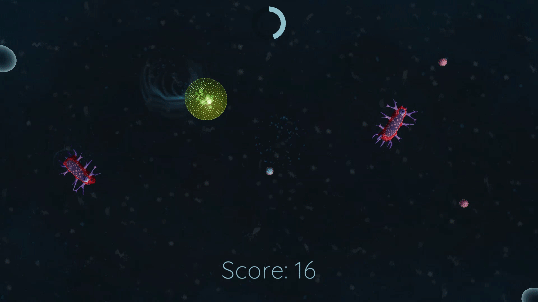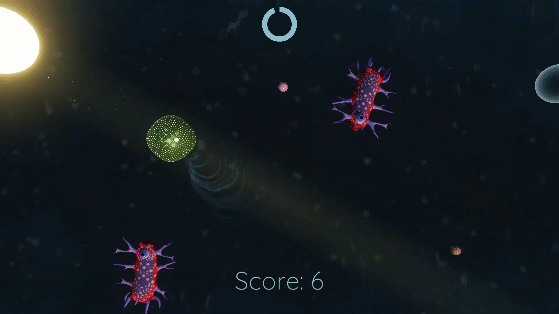Microverse
Concept
Microverse is a 2 player cooperative game where players work together to guide an algae to grow and survive. Each player controls a light to attract and move the algae, coordinating to collect food and avoid predators. This accessible and engaging experience emphasizes teamwork and communication.
2023
12 people
3 weeks
Role & Contributions
Concept & Mechanic: Pitched the core mechanic and collaborated with the team to refine the gameplay.
Research: Researched real-world organisms to fit the setting.
Food Spawning System: Developed the food spawning system.
Level Balancing: Balanced levels by tweaking movement, and adjusting enemy/food spawning.
Key Highlight - Design
1. Leveraged my biology background to create a fitting setting and core mechanic.
2. Developed the concept to emphasize cooperation and promote environmental care through gameplay.
3. Continuously worked on the core design and collaborated with programmers to refine and enhance its implementation.
Core Loop
Communicate and guide
Players communicate to decide which light to turn on or off.
Goal:
Eat as much as possible before time's up!
Level transition
New challenges arise as the creature grows, resetting the loop.
Navigate Challenges
Players use their lights to guide the creature toward food while avoiding enemies.
🦠
Pillars
1. Communication
Controlling algae with two lights encourages player to communicate. In later levels, unpredictable enemies become more common, adding a layer of challenge and emphasizing the need for teamwork.
2. Accessibility
The game should be easy to pick up, with intuitive controls and mechanics that are simple to understand, ensuring accessibility for all players.
3. Informative
While the game takes creative liberties, it is grounded in real creatures and systems. The goal is to spark curiosity and foster a sense of care for nature in players.
Design
Finding the Concept
The game was designed for children, with accessibility in mind for those with lower motor skills, and was intended to be played using Xbox Adaptive Controllers. Our team’s assigned theme was "Microbial Maniacs" entailing a theme of microorganisms.
With these requirements in mind, the team brainstormed ideas. Drawing from my background in biology, I focused on interesting microbes. The Volvox, a beautiful multicellular algae with a fascinating life cycle, caught my attention. While researching, I encountered a video where lights are used to move a Volvox swarm, which sparked the idea for the core mechanic. I pitched this idea to the team, and the team decided to move forward with it.
A thing that really spoke to me with the idea was that if done well, the game could spark scientific curiosity and make players care for the algea that they are helping to survive. The game is not about placing oneself in the algae's shoes, but about simulating a situation where the player is needed and can assist the algae.
Enemies and Points
Points in the game are represented by the daughter colonies inside the Volvox, providing a diegetic way to show the player's score. Each time the Volvox consumes food, it creates a new internal colony, visually reflecting the points gained.

Enemy 1: Vampyrella
The idea for the enemies came from my research into the natural predators of algae. One of the enemies we implemented was Vampyrella, an amoeba. This enemy moves around, attaches itself to the Volvox, and drains its internal colonies (points) and detaches.

Enemy 2: Rotifer
The second enemy was inspired by Rotifers, organisms that create whirlpools with their jaws to draw in food. In our implementation, the Rotifer spawns at random locations, telegraphed by bubbles, before creating a whirlpool that pulls in the Volvox. The Rotifer then extracts an internal colony and launches the Volvox before retreating back into the deep water.

Implementation
Food Spawner
I designed and wrote the food spawn system to allow randomization while controlling spawn positions. The result was a food manager that spawns items at specific empty game objects, which can be placed in the level. It also allows setting the maximum number of food items in play at any time.

The system ensures no two food items spawn at the same point preventing overlapping food items, and when one is eaten, another spawns at a new location. This encourages player movement and adds unpredictability.
Food spawner script
Reflections
This was my first team game project, and it turned out to be a great learning experience. I learned how important it is to have clear communication between different disciplines (design, art, and programming) and how helpful good documentation can be. I often walked over to the programmers to ask questions or let them know about design updates. I found this really fun and realized how much I enjoy working in a team like this.
I was surprised at how useful my background in biology and science was for this project. It’s not something that will always apply so directly in game development, but it was a lot of fun to use that knowledge in a completely new way.
Me and my fellow designers had a lot of interesting discussions about the game design, even down to the smallest details. These talks helped us set a clear direction for the project, though some ideas ended up being more ambitious than what we could accomplish in three weeks. I learned how much I enjoy discussing game design and how it can shape a game, but also that it’s important to keep those discussions focused on what’s realistic for the production timeline.


